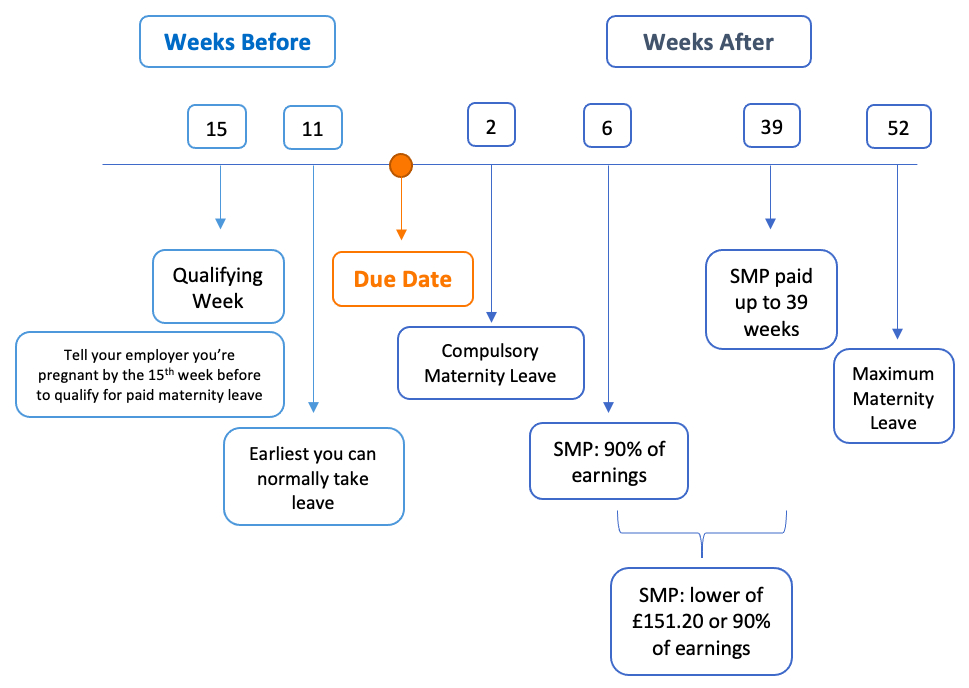
If you need advice on anything in this article, please get in touch with us via the contact form or by telephoning or emailing us. We offer free half-hour advice sessions for employment law.
Maternity Leave
- You are entitled to a maximum of 52 weeks’ maternity leave if you are legally classed as an employee
- This right starts from your first day on the job
- You must take 2 compulsory weeks’ leave after your baby is born (or 4 if you work in a factory)
- After your compulsory weeks, how many of the 52 you take is up to you
Leaving work:
The earliest you are normally able to start your leave is 11 weeks before the week your baby is due.
Exceptions:
- If your baby is born early, leave starts the day after the birth
- If you’re off work for pregnancy-related illness in the 4 weeks before the week of expected childbirth, it will start automatically
- If your baby is late and you told your employer a specific date you wanted to start your maternity leave, you can still leave at that date. You must update your employer on when you give birth, so your compulsory maternity leave starts from then.
If you’re entitled to paid maternity leave, you must tell your employer:
- You’re pregnant no later than the 15th week before the due date
- The date of the week your baby is due
- The date you would like your maternity leave to start.
Your employer must reply within 28 days, confirming the dates of your maternity leave.
Your employer can also suspend you on ‘maternity grounds’ if your health and safety is at risk, for example if you’re pregnant and you work in a lab with radiation. Your employer must take specific steps before suspending you, such as preventing exposure. You are entitled to full pay for up to 26 weeks if you are suspended on maternity grounds.
Keeping in Touch (KIT) Days:
You and your employer can agree that you work for up to 10 days during your maternity leave to help you keep in touch. You can agree with your employer how many KIT days you want, what type of work you will do and how much you’ll be paid.
Returning to work:
- You must give your employer minimum 8 weeks’ notice if you want to change the date you return to work
- If you decide you don’t want to return to work, your contract will normally state what notice to give, but if there is nothing in your contract, you must give at least one week’s notice.
- If your return in the first 26 weeks of maternity leave (ordinary maternity leave), you have the right to return to the same job as you had before.
- If you return after 26 weeks (additional maternity leave), you still have the right to return to your job on the same terms as when you left, but if there have been significant changes in the organisation and this is not possible, you can be offered a similar job. This must not be on worse terms than before.
Back at work:
- You can ask your employer for flexible working, which could mean changing days or hours, working from home or switching your shifts. Bear in mind your employer does not have to say yes.
- Your holiday entitlement continues to build up (‘accrue’) whilst you are on maternity leave. This means when you return to work, you could have a lot of holiday left to take. It is a good idea to agree with your employer how you will take your holiday when you return to work.
- You are protected from discrimination on grounds of maternity. If you believe you have been treated unfairly because of the pregnancy or because of a pregnancy-related illness, you should speak to your employer or a mediator. If that does not solve the issue, you can make a claim against your employer.
- It is against the law for your employer to make you redundant because you have been on maternity leave.
Pay
Statutory Pay:
Statutory maternity pay (SMP) is paid for up to 39 weeks
- First 6 weeks: 90% of your average weekly earnings (before tax)
- Next 33 weeks: the lower of £151.20 or 90% of your average weekly earnings
SMP will be paid in the same way as your wages, e.g., weekly or monthly. Tax and National Insurance will be deducted.
SMP normally starts when you go on maternity leave.
To qualify for SMP you must:
- Have worked continuously for your employer for at least 26 weeks before the qualifying week – the 15th week before the expected week of childbirth
- Earn on average at least £120 a week
- Give notice of at least 15 weeks before your due date
- Give proof you’re pregnant, e.g., a letter from your doctor or midwife, or your MATB1 certificate
- Not go into police custody during your maternity pay period – it will not restart when you’re discharged
If your baby is born early, stillborn after the 24th week, or dies after being born, you can still get Statutory Maternity Leave and Statutory Maternity Pay.
Contractual Pay:
Some employers offer enhanced, contractual maternity pay that will be more than SMP (it cannot be less). Speak to your employer to see:
- If you’re entitled to enhanced maternity pay
- The amount of pay you get
- How long you get it for
Summary Diagram: Maternity Leave & Pay


